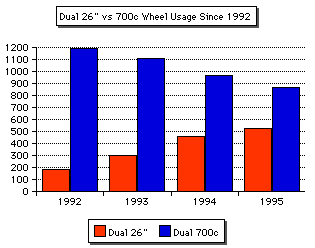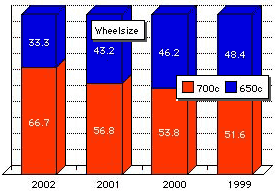Yet more wheel size debates
There are two topics specific to tri bikes that have transcended the technological, and ascended to the religious. Wheel size is one, seat angle is the other.
In point of fact, after two decades of heated declarations and ill-informed pronouncements, there remains not one shred of evidence suggesting one of these wheel sizes is inherently superior to the other. And yet…
…as I was talking to a representative of one of the world's great bike companies, I asked why his smallest women's-specific bike was made with 700c wheels. His answer: "The wheel is faster. If you pedal the same gear at the same cadence, you'll go farther with 700c."
"Using that reasoning," I replied, "Why not use 800c?"
"Because that's not a standard-sized wheel."
When a bike shop owner selling this company's bikes calls and needs to speak to a technical expert, the man I quoted above is the one who gets on the phone and explains the arcanities of bike technology. Obviously there remains a dearth of apologists defending the cause of reason and rationale as regards the size of the wheel you might ride. Though I write about this from time to time, and did so not three years ago, it appears another installment on the issue is in order.
A critical analysis of wheel size requires separating the question into three issues: speed, fit, and handling.
SPEED
Two myths abound: that 650c wheels have more rolling resistance than 700c; and that they are more aerodynamic. No evidence suggests that one wheel generates more friction on the road than the other. As for aerodynamics, yes, the 650c has a smaller frontal profile. But it spins faster, generating more turbulence. It is considered a wash.
Yes, if you make the wheel a disc you get rid of the turbulence, swinging the argument in favor of 650c. But discs are generally found in the bike's rear, and the longer 700c diameter gives the air a place to rejoin — a softer landing, as it were, for the turbulent air finding its way around the rider.
There are things you can do to make a 650c wheel faster. There is no reason the wheel requires the hub flange width you find on a 700c wheel, especially if you're using a deep-section rim. More than 15 years ago, when a bike manufacturer, my company built our 650c wheels around 60mm-wide flanges instead of 80mm, and simply spaced the hubs to still fit into 100mm-spaced dropouts. We also reduced the number of spokes in the wheel. These 650c wheels were exceptionally strong and generated a considerably smaller frontal profile. Bikes we built back then, used with these wheels, were ridden to bike course records in important races that still stand today, though many of the world's best athletes have had their chances at these records and failed to better them.
As one considers the fastest times ever ridden at the Hawaiian Ironman, almost none of the fastest women's bike splits have been ridden aboard 700c wheels. Indeed, some of the fastest men's splits in Kona, ridden between 1989 and 1993, were set aboard 650c wheels, and these bike splits are still among the top-10 ever ridden on the Kona course. Does this mean the 650c wheel is inherently faster? No, just that it's hard to make the case that it's slower.
FIT
For a pair of reasons tri bike head tubes are considerably shorter than road bike head tubes. The first of these is that one's back is flatter on a TT or tri bike, and this is because of aero bars. These bars allow you to ride with a horizontal back for a longer period of time, because you rest your upper body weight skeletally, instead of suspending it muscularly. Second, this "resting" of the upper body means you can get quite low in front, and you can still ride with considerable power if you move your saddle forward, keeping your hip angle sufficiently open.
Making this "lowness" possible is the aerobar, but the very existence of this bar creates a further problem: you have to make room for it. As opposed to road bikes, which only feature a handlebar protruding horizontally from the stem, a tri bike has an additional handlebar bolted on top of this "base" bar. You have to make room for this additional bar, and the way you do this is to shorten the head tube.
All this conspires to cause a tri bike's head tube to terminate lower to the ground than would a road bike's head tube. No problem, up to (or down to) a point. But when the bike gets below 54cm, it starts to get tougher to make a tri bike with 700c wheels and get the head tube's top low enough for the bike fit properly. Below 52cm, tougher. Below 50cm, almost impossible.
If the bike is made with 650c wheels in place of 700c wheels, you get the equivalent of 5cm of head tube height. In other words, a bike with a 9cm head tube and 700c wheels would, if it had 650c wheels instead, require a 14cm head tube in order to accommodate a rider of the same size.
Once you get below 50cm, to 48cm, and 46cm these tri bikes — if built with 700c wheels — would need head tubes of 7cm, 5cm, and perhaps 3cm respectively. The shortest head tubes built in bikes today are about 7.5cm, and few companies can build them this short. Hence the requirement to build these shorter tri bikes with 650c wheels.
HANDLING
When you step back and ask yourself, theoretically, what is the perfect wheel size, and why, this causes some nervous reflection among those who are wedded to a specific wheel size, yet who are critical thinkers. Why is 700c the default perfect size, and who make it so?
Ignoring for the moment the history of tire pressures and cobbled roads in Europe between the world wars, let us just assume that 700c is the default size for good reasons. There must be an archetypal rider for whom 700c is ideal. If you choose the apex of the bell curve, you're looking at — what? — the 54cm or 55cm road bike size in early 20th-Century Europe?
If this is a fair guess, then what of those who diverge from 55cm? Is 700c still you're perfect size if you're 6'2", 6'5", 6'8"? What if you're 5'7", 5'4", 5'1"?
In point of fact, a 650c wheel, with tire mounted, has a radius about 94% the radius of a 700c wheel. If you take that larger wheel and shrink the entire bike, and all its dimensions, to a bike accommodating 650c wheels, you end up with a 49cm bike. In other words, if a 5'6" female bike racer wanted a 49cm bike that handled precisely the same as a 5'10" man aboard a 55cm bike, that smaller bike would have 650c wheels. The bike would literally be 6% smaller in every way, in every dimension.
When you force that 5'6" female to race a bike with the same size wheels as the 5'10" man, she's not racing an equivalent bike. Even though the wheels are identical, the bikes are not. Only if she rides her 49cm bike built around 650c wheels will she know how her taller counterpart's bike handles.

When you go through the analysis of all the above points, the most reasonable conclusion is that both wheel sizes are ideal, and that the decision between them hangs on the size of the rider and the size of his or her bike. Certainly, tri bikes below 50cm ought to be built with 650c wheels. Below that, the smaller the bike the larger the fit and handling penalties, as that bike's builder clings to the 700c wheel size.
Still, the market favors increasing use of 700c. The above graph shows the increase in the use of 650c-wheel bikes in the Hawaiian Ironman during the early 90s, and that's partly due to the fact that from 1991 through 1993 most of the fastest bike splits in both the men's and women's races were ridden atop 650c-wheel bikes.

But by the late 90s the use of 650c wheels had falled off. The trend continues through today, where the great majority of bikes in triathlon's transition areas are built with 700c wheels.
But there are still those who won't ride 700c, and among these tend to be the world's fastest female triathletes, in particular those under 5'7" in stature. Since the advent of the small-wheeled tri bike, in 1989, only twice has the Hawaiian Ironman been won by a female on 700c wheels. One such winner was Karen Smyers, who had to overcome a loss of 12 minutes during the bike leg to eventually run her way to victory. The other occasion occurred this past year, when Michellie Jones emerged the victor. One notable difference between Jones and prior winners was her stature — at upwards of six feet tall a 650c-wheeled bike is not a preference, and would not be indicated.

Two design features of that very fast former age of the early 90s are again gaining in popularity. Virtually all the important new tri bikes are built not with the 75- and 76-degree seat angles typical over the last decade, but with angles between 78- and 79-degrees, as were made 15 and 18 years ago. Right behind this is another design feature making a comeback: many of those companies making tri bikes below 50cm are finding their bikes hard to sell if they're built over 700c wheels. Part of this has to do with the trend toward steeper seat angles. The steeper you ride, the lower your bars can be in relation to your saddle. The lower your bars, the shorter the head tube. Above we describe the problem with head tube height on tri bikes built with 700c.
Do not expect a return to 650c wheels on bikes built in 55cm or 57cm sizes. But do not expect the 47cm and 48cm tri bikes to be built over 700c wheels — these bikes are becoming anchors in the retail stores carrying them. At the moment, 50cm is the size in play — this is bike giving tri bike product managers wheel-size-angst.

